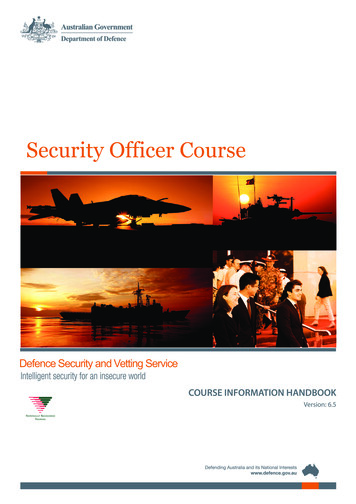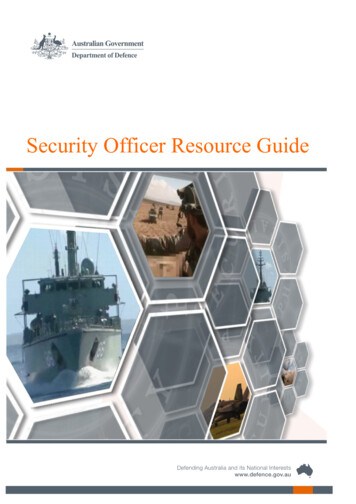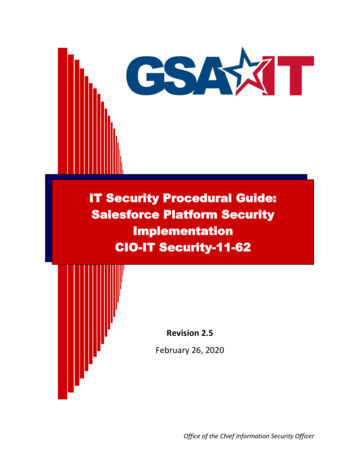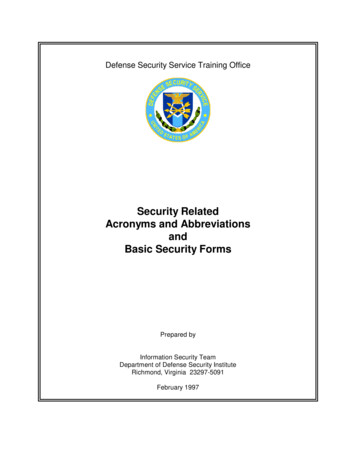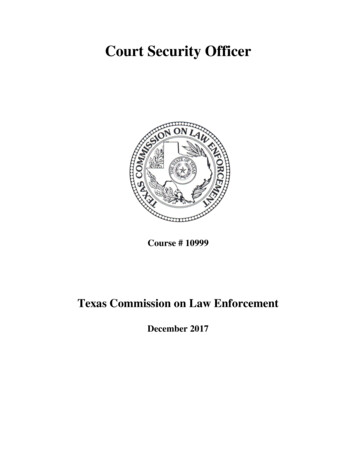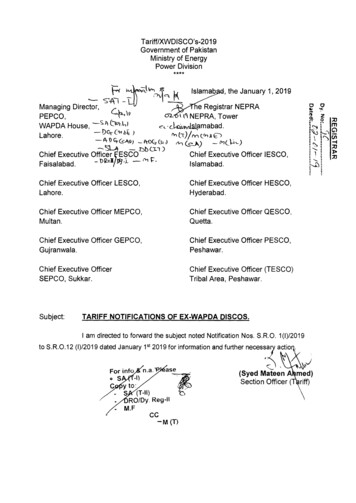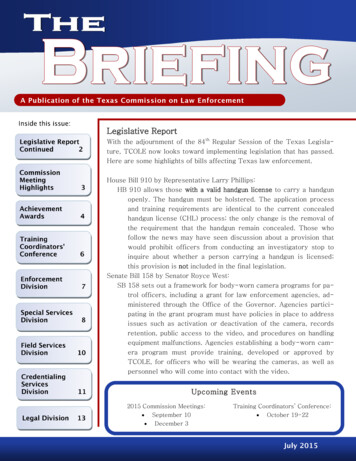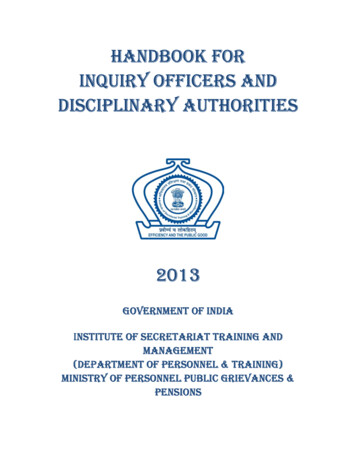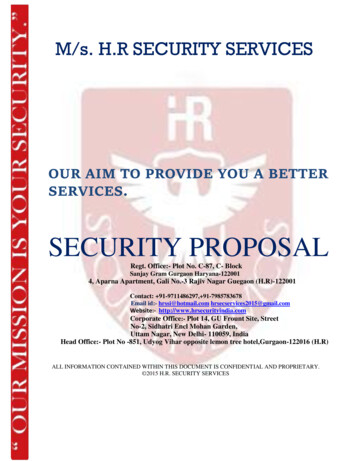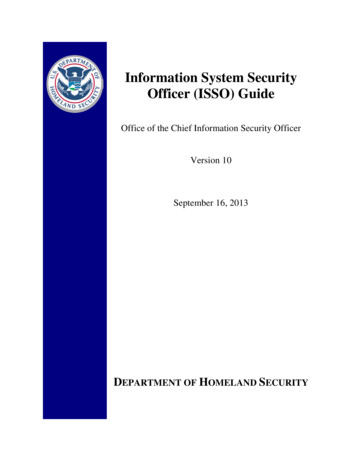
Transcription
Information System SecurityOfficer (ISSO) GuideOffice of the Chief Information Security OfficerVersion 10September 16, 2013DEPARTMENT OF HOMELAND SECURITY
INFORMATION SYSTEM SECURITY OFFICER (ISSO) GUIDEDocument Change HistoryVersionDateDescription0.111/25/09Initial Internal Draft0.212/15/09Revised Internal Draft, corrected formattingand grammatical errors0.31/27/2010Incorporated ISO comments1.03/30/2010Final Version8.06/06/2011 Updated entire document forterminology changes per DHS 4300AVersion 8.0 and NIST SP 800-37 Changed version to match DHS 4300ACreated new section 2.1.2 CriticalControl Review (CCR) Team Updates:o 2.1.1 Document Review (DR)Team;o 2.1.4 DHS InfoSec CustomerService Center;Appendix C: OIG Potential Listing ofSecurity Test Tools & Utilities. 8.09/19/201110i Section 5.1 ISSO letter Attachement Nwas changed to Attachement C. Document updated to reflect new IACStool, Ongoing Authorization, and otherminor changes. ISO changed to DHS OCISO.
INFORMATION SYSTEM SECURITY OFFICER (ISSO) GUIDETABLE OF CONTENTSDOCUMENT CHANGE HISTORY . ITABLE OF CONTENTS . IILIST OF FIGURES . IV1.0INTRODUCTION . 11.1BACKGROUND . 11.2PURPOSE . 11.3SCOPE . 11.4DHS INFORMATION SECURITY PROGRAM. 21.5ESSENTIALS . 22.0ORGANIZATIONAL ROLES, RESPONSIBILITIES AND RELATIONSHIPS . 32.1DHS CHIEF INFORMATION SECURITY OFFICER (CISO) . 42.2COMPONENT CISO / ISSM AND STAFF . 72.3SYSTEM OWNER. 82.4SYSTEM, DATABASE, AND MAJOR APPLICATION ADMINISTRATORS (TECHNICAL STAFF) 82.5BUSINESS OWNER . 82.6SECURITY CONTROL ASSESSOR (SCA) . 82.7AUTHORIZING OFFICIAL . 92.8CHIEF FINANCIAL OFFICER . 92.9CHIEF PRIVACY OFFICER . 92.10 CHIEF SECURITY OFFICER (CSO) / FACILITY SECURITY OFFICER (FSO) . 102.11 DHS SECURITY OPERATIONS CENTER (SOC) . 102.12 CONFIGURATION CONTROL BOARD (CCB) . 102.13 FACILITY MANAGERS . 112.14 PEERS. 113.0ISSO RESOURCES AND TOOLS . 113.1REFERENCES . 113.2DHS INFOSEC CUSTOMER SERVICE CENTER . 164.0SYSTEM ENGINEERING LIFE CYCLE (SELC) . 164.1LIFE CYCLE PHASES. 174.2ISSO RESPONSIBILITIES DURING THE LIFE CYCLE . 215.0ISSO RESPONSIBILITIES . 215.1ISSO LETTER . 225.2ACCESS CONTROL . 235.3ACQUISITION PROCESS. 245.4CONTROL ASSESSMENTS . 25ii
INFORMATION SYSTEM SECURITY OFFICER (ISSO) GUIDE5.5ANNUAL SECURITY AWARENESS AND ROLE-BASED TRAINING . 265.6AUDITS . 275.7AUDITING (LOGGING) AND ANALYSIS . 295.8BUDGET . 315.9SECURITY AUTHORIZATION PROCESS . 325.10 COMMON CONTROLS . 345.11 CONFIGURATION MANAGEMENT (CM) . 355.12 CONTINGENCY PLANNING . 365.13 CONTINUOUS MONITORING . 385.14 IDENTIFICATION AND AUTHENTICATION . 395.15 INCIDENT RESPONSE INCLUDING PII . 395.16 INTERCONNECTION SECURITY AGREEMENTS AND MEMORANDA OF UNDERSTANDING /AGREEMENT . 405.17 INVENTORY . 415.18 MAINTENANCE. 425.19 MEDIA PROTECTION . 425.20 PATCH MANAGEMENT . 425.21 PERSONNEL SECURITY . 435.22 PHYSICAL AND ENVIRONMENTAL SECURITY . 445.23 PLANNING . 465.24 POA&M MANAGEMENT . 475.25 RISK ASSESSMENT . 475.26 SYSTEM AND COMMUNICATIONS PROTECTION . 475.27 SYSTEM AND INFORMATION INTEGRITY . 485.28 SYSTEM AND SERVICES ACQUISITION . 485.29 SYSTEM INTERCONNECTIONS . 495.30 SECURITY TRAINING . 496.0REQUIREMENTS FOR PRIVACY SYSTEMS AND CFO DESIGNATED SYSTEMS . 506.1PRIVACY SYSTEMS . 506.2CFO DESIGNATED SYSTEMS . 507.0ISSO RECURRING TASKS . 537.1ONGOING ACTIVITIES . 537.2ISSO WEEKLY ACTIVITIES . 537.3ISSO MONTHLY ACTIVITIES . 537.4ISSO QUARTERLY ACTIVITIES . 537.5ISSO ANNUAL ACTIVITIES . 537.6AS REQUIRED ACTIVITIES . 54APPENDIX A: REFERENCES . 55iii
INFORMATION SYSTEM SECURITY OFFICER (ISSO) GUIDEAPPENDIX B: ACRONYMS . 58APPENDIX C: OIG POTENTIAL LISTING OF SECURITY TEST TOOLS & UTILITIES . 61LIST OF FIGURESFigure 1. ISSO Interactions. 4Figure 2. SELC Process . 17Figure 3. ISSO Security Authorization Process Relationships . 33iv
INFORMATION SYSTEM SECURITY OFFICER (ISSO) GUIDE1.0INTRODUCTION1.1BackgroundThe Information System Security Officer (ISSO) serves as the principal advisor to theInformation System Owner (SO), Business Process Owner, and the Chief Information SecurityOfficer (CISO) / Information System Security Manager (ISSM) on all matters, technical andotherwise, involving the security of an information system. ISSOs are responsible for ensuringthe implementation and maintenance of security controls in accordance with the Security Plan(SP) and Department of Homeland Security (DHS) policies. In almost all cases, ISSOs will becalled on to provide guidance, oversight, and expertise, but they may or may not develop securitydocuments or actually implement any security controls. While ISSOs will not actually performall functions, they will have to coordinate, facilitate, or otherwise ensure certain activities arebeing performed. As a result, it is important for ISSOs to build relationships with the SO,technical staff, and other stakeholders as described in this document.This guide provides basic information to help ISSOs fulfill their many responsibilities and servesas a foundation for Components to develop and implement their own ISSO guidance. It alsoprovides techniques, procedures, and useful tips for implementing the requirements of the DHSInformation Security Program for Sensitive Systems.This guide is a compilation of the best practices used by DHS Components and requirementscontained in various DHS policies and procedures, National Institute of Standards andTechnology (NIST) publications, Office of Management and Budget (OMB) guidance andCongressional and Executive Orders.1.2PurposeISSO duties, responsibilities, functions, tasks, and chain of command vary widely, even withinthe same Component. The document provides practical guidance to assist DHS ISSOs whenperforming assigned tasks. It addresses and explains the responsibilities, duties, tasks, resources,and organizational relationships needed for an ISSO to be successful. ISSOs should use thisdocument as a guide as it applies to their circumstances.This document is meant to be a companion document to, and an elaboration of, the various DHSManagement Directives (MDs), Information Technology (IT) Security Policies and Handbooks(e.g., DHS 4300A), as well as the procedures and tools to implement those policies.1.3ScopeThe ISSO Guide provides practical guidance based on DHS directives and policies applicablethroughout the Department. Many Components have additional guidance that tailors DHSguidance to meet specific Component requirements. In all cases, Component guidance should beused as the primary reference source as long as it is consistent with DHS directives and policies.The information in this guide is intended to support ISSO responsibilities for Sensitive ButUnclassified (SBU) systems. Although much of the information in this guide is applicable to1
INFORMATION SYSTEM SECURITY OFFICER (ISSO) GUIDEISSOs for Classified systems, it cannot be considered authoritative for information systemsprocessing National Security Information, Sensitive Compartmented Information (SCI),Cryptographic/Cryptologic data, or Special Access Programs. ISSOs for those excluded systemsare guided by separate documentation including but not limited to the:1.4 DHS 4300B National Security System Policy DHS 4300B National Security Systems Handbook DHS 4300C Sensitive Compartmented Information (SCI) Systems Policy Directive DHS SCI Systems Information Assurance HandbookDHS Information Security ProgramThe DHS CISO is responsible for implementing and managing the DHS-wide InformationSecurity Program to ensure compliance with applicable Federal laws, Executive Orders,directives, policies, and regulations.To help with these responsibilities, the DHS Office of the Chief Information Security Officer(OCISO) has the mission and resources to assist in ensuring Department compliance withinformation security requirements. DHS OCISO is organized into four directorates: InformationSecurity Program Policy, Compliance and Technology, Cybersecurity Strategy, and InformationSecurity Program Management. ISSOs will have the most interaction with the Compliance andTechnology Directorate, which includes the DHS InfoSec Customer Service Center, Plan ofAction and Milestones (POA&M), document review, inventory, and scorecard functions.The DHS Information Security Program does not apply to systems that process, store, or transmitNational Intelligence Information.1.5EssentialsThe goal of information security is to help the business process owner accomplish the mission ina secure manner. To be successful, ISSOs need to know and understand the following: Mission and business functions of the organization (e.g., an ISSO for a procurementsystem should know that no maintenance or down time should be scheduled duringthe fourth quarter, which is extremely busy)How the system supports the organization’s missionSystem details, including: Architecture System components (hardware, software, peripherals, etc.) Location of each system component Data flow Interconnections (internal and external) Security categorization2
INFORMATION SYSTEM SECURITY OFFICER (ISSO) GUIDE 2.0 Security requirements Configuration management processes and proceduresUsers (How many, location, etc.)Key personnel by nameORGANIZATIONAL ROLES, RESPONSIBILITIES ANDRELATIONSHIPSThe key to success for an ISSO is to build relationships with key personnel who have theauthority or ability to ensure compliance with security laws, regulations, guidance andrequirements. Key people will differ depending on circumstances. Therefore, throughout thisguide, ISSOs are encouraged to coordinate with appropriate contacts as determined by theirComponents and different situations that arise with their systems.This section discusses the organizational relationships between the ISSO and key personnel withwhom the ISSO interfaces. It emphasizes the type of information each can provide and thesuggested frequency of contact. Roles and responsibilities are included only as they are relevantto the ISSO. For a more detailed description of individual roles and responsibilities, see DHS4300A Sensitive Systems Handbook. Sections below discuss the nature of those relationshipsand the types of information exchanged in each case.3
INFORMATION SYSTEM SECURITY OFFICER (ISSO) GUIDEFigure 1. ISSO Interactions illustrates the people the ISSO will interact with on a regular basis.Descriptions of these relationships are provided in the following sections.Figure 1. ISSO Interactions2.1DHS CHIEF INFORMATION SECURITY OFFICER (CISO)The DHS CISO implements and manages the DHS Information Security Program to ensurecompliance with applicable Federal laws, Executive Orders, directives, policies, and regulations.The DHS CISO reports directly to the DHS Chief Information Officer (CIO) and is the principaladvisor for information security matters.The DHS CISO issues Department-wide information security policies, guidance, and architecturerequirements for all DHS IT systems and networks based upon guidance from NIST as well asall applicable OMB memoranda and circulars. The CISO also facilitates the development ofsubordinate plans for providing adequate information security for networks, facilities, andsystems or groups of information systems.4
INFORMATION SYSTEM SECURITY OFFICER (ISSO) GUIDEISSOs are assigned duties and tasks that directly support these CISO responsibilities. SpecificCISO responsibilities at the Department and Component levels can be found in the InformationSecurity Program Roles section of DHS 4300A. The DHS CISO has several teams available tohelp ISSOs perform their duties and assess the effectiveness of policy, guidance, and overallprogram structure. In all cases, ISSOs should work through their Component CISO / ISSM andfollow Component-specific procedures to request support from DHS.DHS OCISO teams are described in detail below and include the: Document Review (DR) Team Ongoing Authorization Inventory Team Plan of Action and Milestones (POA&M) Team DHS InfoSec Customer Service CenterMany Components have a similar structure with an internal FISMA compliance function. KeyDHS teams include those described below.2.1.1Document Review TeamThe DHS DR Team reviews and validates Security Authorization Process documents uploadedin the Information Assurance Compliance System (IACS). The DR Team uses a checklist toensure Security Authorization Process documents are complete and comply with DHS guidancecontained in DHS 4300A, NIST Special Publication (SP) 800-53, the annual Performance Plan,and the DHS Security Authorization Process Guide. Security Authorization Process checklistsare available on the DHS CISO website.The DR team provides feedback on each package it reviews by providing the ISSO orComponent CISO team with a completed DR checklist. After the checklist has been provided,the DR Team conducts a conference call with the Component to provide additional feedback,answer questions, and consider any additional information the Component may provide. ISSOsshould ensure they participate in these feedback sessions along with any other stakeholders in theSecurity Authorization Process.Contact with the DR team is normally made via the Component CISO/Compliance team. ISSOsshould understand local requirements before contacting the DR team directly.2.1.2Ongoing AuthorizationAs stated in NIST 800-137, Information Security Continuous Monitoring for FederalInformation Systems and Organizations, “initial system authorization is based on evidenceavailable at one point in time, but systems and environments of operation change.” To addressthe needs of constantly changing environments, DHS is implementing OA, which involvesshifting from periodic to ongoing assessments and facilitates a continual state of awareness.DHS implements OA in three layers, which collectively ensure constant control assurance. Layer 1: Common and Inherited Controls and Reciprocity5
INFORMATION SYSTEM SECURITY OFFICER (ISSO) GUIDE Layer 2: Continuous MonitoringLayer 3: Event-Driven MonitoringEvent-Driven Monitoring (Layer 3) involves evaluating and testing controls when securityevents or “triggers” occur that may have an impact on the system’s security status. Following anevent, a review is conducted to determine the impact on the status of controls and risk to thesystem. Some key process highlights include the following: An Operational Risk Management Board (ORMB), composed of various subject matterexperts, evaluates security triggers and makes risk-based recommendations.Following ORMB review, the CISO prepares a formal recommendation to theAuthorization Official (AO) about whether or not to maintain the authorization.Security triggers are to be reported in the Component’s Trigger Accountability Log (TRAL) andprovided to DHS on a monthly basis.To qualify for OA, the following prerequisites must be met: The system must have a valid ATO.The information system must have a Control Allocation Table (CAT).The Component should have a Common Control Catalog in place.The Component must have a robust Continuous Monitoring program.The Component must assign an OA Manager.The Component must establish an ORMB.The Component must offer an OA training program.The Component must accept and sign the DHS OA Memorandum of Agreement (MOA).For more information about ongoing authorization, please refer to the Ongoing AuthorizationMethodology guide.2.1.3Inventory TeamThe DHS Inventory Team maintains the official inventory of all DHS systems, including GeneralSupport Systems (GSSs), Major Applications (MAs), sub-systems, and minor applications. Theinventory of GSSs and MAs are maintained in the IACS tool while all other sub-systems andminor applications are maintained in an off-line database at DHS. Information on sub-systemsand minor applications may be obtained through the Component CISO office.The Inventory Team in conjunction with the DHS InfoSec Customer Service Center processes allinventory change request forms and conducts the Annual Inventory Refresh effort, which focuseson maintaining an accurate inventory by conducting interviews with key personnel andinvestigating discrepancies. The DHS FISMA System Inventory Methodology, available on theDHS CISO webpage, provides guidance for determining system boundaries and procedures forsubmitting change requests.6
INFORMATION SYSTEM SECURITY OFFICER (ISSO) GUIDE2.1.4Plan of Action and Milestones (POA&M) TeamThe DHS POA&M Team is responsible for monitoring the status of POA&Ms, assistingComponents in improving the quality and effectiveness of their POA&Ms, and providingPOA&M guidance.The DHS POA&M Team is available for POA&M training and Assist Visits that can berequested through the Component CISO to the DHS InfoSec Customer Service Center. Trainingcan cover a range of topics. Assist Visits usually involve Subject Matter Experts (SMEs) fromDHS working with small groups at the Component to deal with specific issues, such asdeveloping POA&Ms for audit findings or using IACS reports. Assist Visits can be used to helpdevelop real POA&Ms based on real vulnerabilities.ISSOs should be thoroughly familiar with DHS 4300A, Attachment H, POA&M Process Guide.2.1.5DHS InfoSec Customer Service CenterThe DHS InfoSec Customer Service Center provides help desk-type support for the IACS tool(e.g., reset passwords) and serves as the focal point for questions about the DHS InformationSecurity Program or any of its elements (e.g., DR, inventory, POA&M, etc.). Services providedinclude account maintenance, PO&AM support, Document Review and FISMA guidance as wellas review and implement FISMA Inventory change requests. The DHS InfoSec CustomerService Center has access to a variety of Subject Matter Experts (SMEs) and can provide anauthoritative response to questions regarding the DHS Information Security Program. ISSOsshould use the chain of command and resources within their Component to try to resolvequestions but should not hesitate to use the DHS InfoSec Customer Service Center as a resourcewhen needed.2.2Component CISO / ISSM and StaffThe Component CISO team should be a primary source of information and assistance for allISSOs. ISSOs should become familiar with the organization and people in their CISO office sothey can request assistance when needed. Often, the Component CISO staff can provide specificanswers to questions about the Security Authorization Process, POA&Ms, requirements, theIACS tool, training, policies and procedures, and where else to go to get answers. In some cases,the CISO office may even provide resources to help with specific issues (e.g., scans, SecurityAssessment Plans, etc.).The Component CISO team is also the principle conduit for all requests to DHS OCISO fortraining, document reviews, or other support. All requests for support or questions concerningpolicy or implementation of security controls must be routed through the CISO or designatedrepresentative. DHS will process requests for the following only when submitted by theComponent CISO or designee: IACS access ISSO Training Waivers and exceptions7
INFORMATION SYSTEM SECURITY OFFICER (ISSO) GUIDE 2.3Security Authorization Process document reviewSystem OwnerSystem Owners (SO) use information technology to help achieve mission needs within theirprogram area of responsibility. ISSOs are responsible for supporting their SOs to ensure theyunderstand security requirements and implications of not meeting them. The ISSO’s goal shouldbe to help the SO operate the system as securely as possible to fulfill mission requirements.However, SOs are ultimately responsible for the security of their systems and must ensure thateach of their systems is deployed and operated in accordance with DHS policy and guidance.The SO is the ISSO’s primary source of information and resources. In most cases, the ISSOworks directly for and reports to the SO. ISSOs should maintain frequent, if not daily, contactwith their SOs.SOs are responsible for designating an ISSO in writing for each information system under theirpurview. See Section 5.1 for additional information on ISSO letters.2.4System, Database, and Major Application Administrators (Technical Staff)Technical staff are directly responsible for implementing most technical security controls.System security cannot be effective without their active participation. Conversely, technical stafffocus on ensuring the system is available for their users and can also be a primary source ofvulnerabilities. ISSOs should know key technical personnel for their systems by name andshould coordinate with them frequently as part of the continuous monitoring process.Technical staff are a primary source of information for the Security Authorization Process,annual assessments, audits, determining whether Information Security VulnerabilityManagement (ISVMs) messages are applicable and addressed, Contingency Plans and tests,training, and a number of other issues.2.5Business OwnerThe Business Owner has different functions within each Component or organization. In general,business owners are responsible for ensuring the mission of the organization is accomplished. Insome cases, business owners are responsible for funding and other resources that support theirline of business. Although ISSOs will seldom interface with the business owner, it is importantthey understand the organization’s business functions to help ensure business is conducted assecurely as possible. For example, an ISSO for a procurement system should know maintenanceor down time should not be scheduled during the fourth quarter of the fiscal year because of thecriticality of the support functions.2.6Security Control Assessor (SCA)A Security Control Assessor (SCA) (formerly Certifying Official) is a senior managementofficial who verifies the results of the security assessment and makes an authorizationrecommendation to the Authorizing Official (AO). Even if ISSOs are not conducting the8
INFORMATION SYSTEM SECURITY OFFICER (ISSO) GUIDESecurity Authorization, they will have a role in providing data and coordinating activities. It isessential for ISSOs to coordinate with their SCA at the initial Security Authorization andthroughout the system lifecycle to ensure they understand requirements, schedules, andprocesses.2.7Authorizing OfficialThe AO formally assumes responsibility for operating an information system at an acceptablelevel of risk. The DHS CIO serves as the AO for all enterprise systems or designates an AO inwriting. The Component CIO serves as the AO for Component information systems ordesignates one in writing. The DHS Chief Financial Officer (CFO) serves as the AO for CFOdesignated financial systems managed at the DHS level. The Component CFO is the AO forCFO designated financial systems managed by the Component.ISSOs generally have limited interaction with their AOs except during the SecurityAuthorization Process and whenever there is a need to accept risks. In most cases, ISSOs willinteract with their AO through the SCA or follow Component-specific processes. In either case,ISSOs should ensure they understand the AO’s expectations and the process for presenting theATO letter for signature early in the Security Authorization Process.ISSOs should also brief the AO whenever there is a significant change to system risk or sys
Sep 16, 2013 · Information Security Program for Sensitive Systems. This guide is a compilation of the best practices used by DHS Components and requirements contained in various DHS policies and procedures, National Institute of Standards and Technology (NIST) publica
